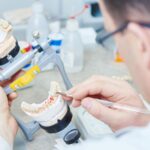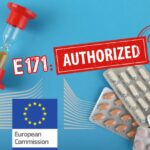
Nanos and dental care

Nanos and dental care
By the AVICENN team – Last updated March 2025
Nanomaterials found in dental products
In the field of dentistry as in others, it is difficult today to distinguish between “promises” still in the research & development stage and nano applications that are actually commercialized. Nanoparticles have been used in dental composites for decades.
In France, the 2017 R-Nano report card lists three “entities” (companies) that reported nano for “the manufacture of instruments and supplies for medical and dental use”.
This report identifies several substances declared in nanoparticulate form as being used in the manufacture of “dental products” (or “for dental use”): aluminum oxide, iron oxide, silica (without however providing further details on the manufacturers or the type of products, properties or quantity of the registered nano substances).
According to Gardon-Mollard, Ph.D., a doctor of Dental Surgery, nanoparticles could be found in dental practices1Who’s afraid of Dental Material Toxicity, The Dentalist, October 2019:
- in sealing cements (zinc oxyphosphates, CVIMAR…)
- in calcium silicates (Biodentine)
- in impression materials (elastomers)
- in composites and adhesives, dispersed mainly during polishing operations if these are carried out without spray or suction.
- In French :
- Les nanomatériaux au cabinet. Les repérer pour promouvoir la santé, Alice Baras, Élisabeth Dursun, Mathilde Detcheverry, L’information dentaire, janvier 2024
- Nanoparticles and Dental Biomaterials, Elisabeth Dursun, 21st Public Health Day, ASPBD, November 4, 2021 (from the 33rd minute)
- Invention: Bringing smiles back with nanomaterials, European Patent Office (EPO), April 2021
- Nanoparticles – Part 1: Description, potential health risks and applications in dentistry, Julie Gorse, Jean-Pierre Attal, Élisabeth Dursun, BioMatériaux Cliniques, 6(1), March 2021
- Nanoparticles in odontology, Julie Gorse, thesis, University of Paris, UFR of Odontology – Montrouge, November 2020
- Development in Iran of dental adhesive manufacturing technology, IRNA (Iran), September 2020
- Who is afraid of the Toxicity of Dental Materials? The Dentalist, October 2019
- Contribution of nanotechnologies to the treatment of periodontitis: systematic literature review, Thesis by Nicolas Moignot, Université Paris Descartes, Sciences du Vivant, 2019
- An army of microrobots to clean plaque, Futura Sciences, May 2, 2019: “Iron oxide nanoparticle-based microrobots can remove bacterial biofilms while being precisely directed by magnets”
- “Forever” fillings now a reality?, Sputnik France, January 31, 2018: Canadian researchers have developed a new type of filling that protects teeth from microbial attack thanks to antibiotic nanoparticles embedded in the filling, the journal Nature Communications announced
- Nanos: a filling that kills bacteria and remineralizes the tooth, Techniques de l’ingénieur, May 2012: calcium phosphate nanoparticles (to regenerate tooth minerals) and silver nanoparticles (antibacterial).
- Nanoparticles in dental products, Candulor, date ?
- Biological evaluation of medical devices containing nanomaterials, Afssaps (now ANSM), February 2011 (“Dental and orthopedic products”, pages 21-24)
- In English:
- A Comprehensive Narrative Review of Nanomaterial Applications in Restorative Dentistry: Reinforcement and Therapeutic Applications (Part II), Elmarsafy S M, Cureus, 17(3), mars 2025
- …
- UQ’s advanced nanotechnology to improve success of dental implants, The University of Queensland, June 11, 2020
- Applications of nano-materials in diverse dentistry regimes, Foong L et al, RSC Adv. 10: 15430-15460, 2020
- Nanoparticles as Anti-Microbial, Anti-Inflammatory, and Remineralizing Agents in Oral Care Cosmetics: A Review of the Current Situation, Nanomaterials, Carrouel F et al, 10(1), 140, 2020
- Mathym’s products, currently used in dental products (France), date ?
- Researchers use antibacterial nanoparticles to prolong dental restorations, Dental Tribune, May 10, 2019
- “A safe and effective way to whiten teeth with nanoparticles,“ Nanowerk with American Chemical Society (ACS), July 2018
- Nanoparticles used in dentistry: A review, Priyadarsini S et al, Journal of Oral Biology and Craniofacial Research, 8(1): 58-67, 2018
- Metal TiO2 nanotube layers for the treatment of dental implant infections, Roguska A et al, ACS Applied Materials & Interfaces, 2018
- Application of Nanomaterials in Dentistry, Qasim S., Rehman IU, in: Micro and Nanomanufacturing, Volume II, Jackson M., Ahmed W. (eds) Springer, Cham, 2018
- to complete…
What are the known risks?
Routes of exposure and risks
Few “public” resources on the specific risks of nanoparticles in dental products are available online.
According to dental care professionals, the nanoparticles are confined in a resin that, once hardened, prevents the nanoparticles from dispersing. Only a very small number of nanoparticles are likely to be ingested as a result of product wear or abrasion – and in much smaller proportions than those coming from food or toothpaste, lipsticks and lip balms, etc.
However, the European Agency for Safety and Health at Work points out that “Milling, drilling, grinding and polishing of applied medical materials containing nanomaterials during dental and surgical procedures represent possible exposure situations. This is the case, for example, in the treatment of tooth decay in dental care, where fillings containing nanomaterials (e.g., nanoceramic fillings) are usually placed and adjusted to the anatomical shape by grinding the surface with high-speed tools. During this procedure, there is a risk that nanoparticles will disperse into the air and be inhaled by the patient and medical personnel”2Nanomaterials in healthcare: occupational hazards and their prevention, EU OSHA, E-facts 73, 2013.
These situations of exposure to nanomaterials exist throughout the life cycle of the material. The prosthetist can be exposed to it by inhalation during the elaboration of the material. The patient and the practitioner can be exposed, during polishing or material removal, by inhalation – and to a lesser extent by swallowing for the patient3Cf. presentation by Prof. Elisabeth Dursun,“Nanoparticles and dental biomaterials” at the 21st Public Health Day, organized by ASPBD on November 4, 2021, 0:45′..
Unfortunately, actual benefit/risk assessments are few and far between and prevention currently limited.
- In French :
- Les nanomatériaux au cabinet. Les repérer pour promouvoir la santé, Alice Baras, Élisabeth Dursun, Mathilde Detcheverry, L’information dentaire, janvier 2024
- Nanoparticles and Dental Biomaterials, Elisabeth Dursun, 21st Public Health Day, ASPBD, November 4, 2021 (from the 33rd minute)
- Guide du cabinet de santé écoresponsable, Alice Baras, Presses de l’EHESP, October 2021
- Eco-responsible approach in the dental office, Alice Baras, Association Dentaire Francaise (ADF), September 2021
- Nanoparticles in odontology, Julie Gorse, thesis, University of Paris, UFR of Odontology – Montrouge, November 2020
- Who is afraid of the Toxicity of Dental Materials?The Dentalist, October 2019
- After food, the suspension of titanium dioxide in toothpastes and medicines?AVICENN, Veillenanos.fr, March 2019
- Investigation report on the presence of titanium dioxide in toothpastes, Act for the Environment, March 2019
- Nanoparticles in dental products, Candulor, date ?
- In English:
- Progress of Nanomaterials in Preventative and Restorative Dentistry, Rattan S et al, Recent Progress in Materials, 2022
-
Nanoparticles as Anti-Microbial, Anti-Inflammatory, and Remineralizing Agents in Oral Care Cosmetics: A Review of the Current Situation, Nanomaterials, Carrouel F et al, 10(1), 140, 2020
- Use of nanomaterials in dentistry: covariates of risk and benefit perceptions among dentists and dental hygienists in Norway, Xenaki V et al, Acta Odontologica Scandinavica, 78(2), 2020
- Nanomaterials in dentistry: a cornerstone or a black box?, Pokrowiecki R et al, Nanomedicine, 13(6), 2018
- Can degradation products released from dental implants affect peri-implant tissues, Noronha Oliveira M et al, Journal of periondontal research, 53(1): 1-11, February 2018
- Histologic investigation of cytotoxicity of nanocomposite particles used for direct restorations in dentistry in rat models, Gimaletdinova AM et al, Kazan medical journal, 98(5), 2017
- Biological evaluation of medical devices containing nanomaterials, Afssaps (now ANSM), February 2011 (“Dental and orthopedic products”, pages 21-24)
- to be completed…
Possible precautionary measures
Some precautionary operating measures can be adopted during milling, polishing, etc. to limit, in fine, the exposure to nanomaterials. Élisabeth Dursun mentions some of them during a conference in November 20214Cf. intervention of Prof. Élisabeth Dursun, “Nanoparticles and dental biomaterials” organized by the ASPBD on November 4, 2021 during the 21st day of public health, based on recommendations of the French-speaking Society of Dental Biomaterials (SFBD):
- carve out the restoration in detail before it sets, to reduce the amount of material milled for finishing and polishing
- use water to cool and more efficient suction during polishing
- ventilate the premises frequently
- protect staff:
- wear FFP3 masks and glasses when polishing
- keep the assistants at a safe distance during polishing
- prefer powder/liquid capsule systems
- use a rubber dam for finishing when occlusion is not a concern
- pay particular attention to vulnerable patients (asthma, chronic bronchial obstruction, etc.)
Any questions or comments? This information sheet compiled by AVICENN is intended to be completed and updated. Please feel free to contribute.
Our information sheets to go further
Upcoming Nano Agenda

- Scientific conference
- 23rd International conference on Advanced Nanomaterials
- From July 23 to July 25, 2025
- Website: www.advanced-nanomaterials-conference.com

- E-learning program: awareness-raising for personnel who come into contact with nanomaterials during research, formulation, production, maintenance, cleaning, upkeep, etc., as well as safety coordinators or engineers, facility managers, heads of laboratories where nanoparticles are handled.
- Organizers: INSTN Grenoble (CEA)
- On the program:
- 1 – Introduction, definition and characteristics of nanomaterials
- 2 – Toxicity of nanomaterials: the state of knowledge
- 3 – Metrology and characterization of nanomaterials
- 4 – Prevention and protection against nanomaterials in the workplace
- 5 – Quiz: assessment of learning outcomes
- The 2-hour course can be viewed for one month from the date of registration.
- Website: https://instn.cea.fr/…risques-lies-aux-nanomateriaux…

- E-learning program: awareness-raising for personnel who come into contact with nanomaterials during research, formulation, production, maintenance, cleaning, upkeep, etc., as well as safety coordinators or engineers, facility managers, heads of laboratories where nanoparticles are handled.
- Organizers: INSTN Grenoble (CEA)
- On the program:
- 1 – Introduction, definition and characteristics of nanomaterials
- 2 – Toxicity of nanomaterials: the state of knowledge
- 3 – Metrology and characterization of nanomaterials
- 4 – Prevention and protection against nanomaterials in the workplace
- 5 – Quiz: assessment of learning outcomes
- The 2-hour course can be viewed for one month from the date of registration.
- Website: https://instn.cea.fr/…risques-lies-aux-nanomateriaux…
This sheet was originally created in February 2019
Notes and references
- 1Who’s afraid of Dental Material Toxicity, The Dentalist, October 2019
- 2Nanomaterials in healthcare: occupational hazards and their prevention, EU OSHA, E-facts 73, 2013
- 3Cf. presentation by Prof. Elisabeth Dursun,“Nanoparticles and dental biomaterials” at the 21st Public Health Day, organized by ASPBD on November 4, 2021, 0:45′.
- 4Cf. intervention of Prof. Élisabeth Dursun, “Nanoparticles and dental biomaterials” organized by the ASPBD on November 4, 2021 during the 21st day of public health






